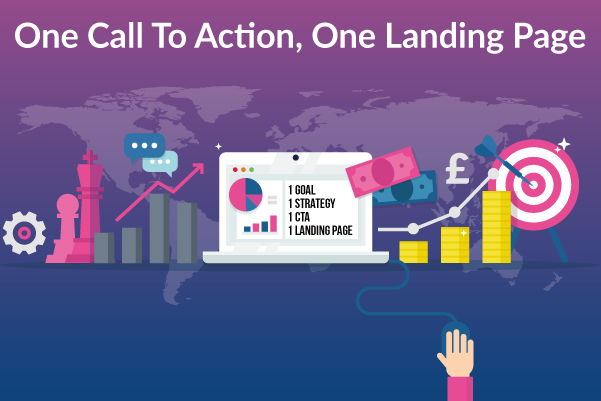One call to action, one landing page
One of the hardest things when thinking of a marketing campaign is how to add the right elements to generate leads and convert these to clients. The steps to follow are not always easy and a strong and well-thought strategy is required for every single step.
Here at Angels, after working with thousands of clients, we would say that the golden rule that has always worked is: One objective -> One strategy -> One Call to Action -> One landing page.
We’ll now explain this more in detail.
Your campaign objective: what do you want to achieve?
There’s always a reason why we want to run a marketing or advertising campaign. Regardless of the channel we choose (email, social media, banners, content, etc), we will always design a strategy according to this objective, which could be any of the following: increasing brand awareness, increasing the engagement or number of followers, app installs, increasing the number of conversions, generating traffic to your website, newsletter sign-ups, lead generation…there are many more.
After the pandemic and the struggles of the property industry, both agents and suppliers have increasingly turned to campaigns to generate leads, so then they can nurture them and convert them to clients.
Having lead generation as an objective requires a very specific strategy and campaign implementation. We’ll need a landing page, which is a marketing element specifically designed to capture leads so we can start the nurture process.
How, though, do we build an effective landing page? And most importantly: how do we take our potential customers to our landing page so we can get what we want from them?
The successful strategy and landing page
Part of your strategy will require you to write and work on the visual content of your marketing elements: your email, your banner or your blog. Your text (or copy) will have to be optimised to sell, your creatives should be visually attractive and related to the copy, and all the elements should be strategically built and designed.
But don’t forget a crucial element: you need a CTA (Call to Action) that is included in all the elements of your campaign.
The CTA will encourage your target audience to take the specific action that you want them to take. In this case, as you want leads, you want them to supply their name, email and possibly mobile number for you to contact them.
Your audience will be encouraged to click on the CTA as long as you offer them something valuable that makes them think that it’s worth clicking on your CTA. Here’s where you’ll need a lead magnet (click here to learn more about lead magnets!).
But, once they click on the CTA, where are they going to be taken to?
They’ll be diverted to your landing page.
A well-built landing page will have your logo, a headline and main image about the product/service you’re advertising, 3 main benefits of your product/service, and if you can, some testimonials of happy clients. But the most crucial part is a lead capture form, preferably on the top-right hand side with a button to submit details.
It’s vital that the landing page has no links to anywhere else, as you want your lead to only give their details with no distractions at all. They already had the chance to click to your site, product/service information or find out more on Google about you before clicking the CTA.
Now they’re ready to give you their details in exchange for the lead magnet you offered them before, and we don’t want them to click on a link that will take them somewhere else. We want them to focus on giving us their details.
And now… great news! You have your lead name and email, and possibly their phone number, and you can start the customer nurture journey to convert them into clients. With a good nurture strategy, you’ll get them.
Wait… I have more than one campaign objective. What should I do?
That’s a great question, and that’s what we want to explain in this blog.
Your business can have more than one objective. But your campaigns cannot. This would cause confusion and distractions in your marketing content and the chances of having a successful campaign would dramatically decrease.
Per every objective, you need to design a different strategy, hence the different content for your campaigns, different copy and creatives, different CTAs and, of course, different landing pages.
All the above elements need to be kept consistent and need to be focused on only one core message related to only one objective.
For instance, your objectives for the next 6 months are: 1) generate leads and 2) increase traffic to your website.
You’ll design two different campaigns for these two objectives, different emails, banners, Facebook and Google Ads, different content, promoting different things, that you can run simultaneously if you want. You’ll design a landing page for the lead generation campaign, and you will design a campaign that will divert your lead to your site for the traffic campaign, as you won’t even be needing the same campaign elements.
That’s why it is so important to design independent campaigns for every different business objective. This will be the key to successful campaigns that will lead to desired results.
It’s not easy, but we are here to help. If you want to know which the best strategy would be for your business objectives and what campaigns would work best, just email us at lee@angelsmedia.co.uk or call us on 020 663 4989 and we’ll work together.
